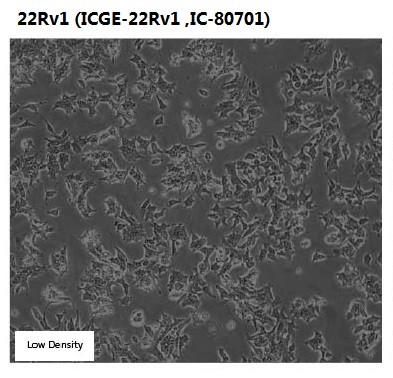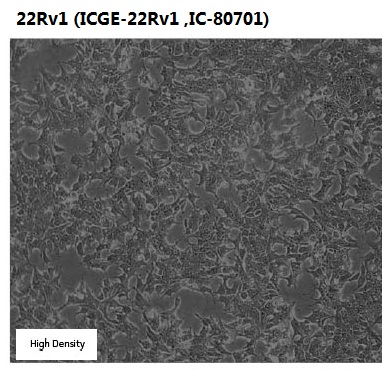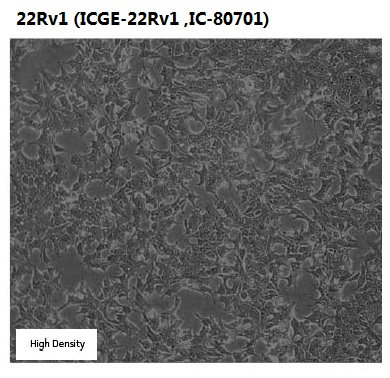


Overview
| Organism | Homo sapiens, human |
|---|---|
| Tissue | prostate |
| Cell Type | epithelial |
| Product Format | frozen |
| Morphology | epithelial |
| Culture Properties | adherent |
| Biosafety Level |
2
Biosafety classification is based on U.S. Public Health Service Guidelines, it is the responsibility of the customer to ensure that their facilities comply with biosafety regulations for their own country. |
| Disease | carcinoma |
| Storage Conditions | liquid nitrogen vapor phase |
Properties
| Karyotype | 49,XY,del(1)(p10),+i(1)(q10),der(2)t(2;4)(p13;q31)del(2)(q13q33),der(4)t(2;4)(p13;q31),t(6;14)(q15;q32),+7,+12[5]/50,idem,+3[1] |
|---|---|
|
|
|
| Derivation |
22Rv1 is a human prostate carcinoma epithelial cell line derived from a xenograft that was serially propagated in mice after castration-induced regression and relapse of the parental, androgen-dependent CWR22 xenograft.
|
| Antigen Expression |
prostate specific antigen (PSA)
|
| Receptor Expression |
androgen receptor
|
| Tumorigenic | Yes |
| Effects |
Yes, forms tumors in nude mice
|
| Comments |
The cell line expresses prostate specific antigen (PSA). Growth is weakly stimulated by dihydroxytestosterone and lysates are immunoreactive with androgen receptor antibody by Western blot analysis.
Growth is stimulated by epidermal growth factor (EGF) but is not inhibited by transforming growth factor beta-1 (TGF beta- 1).
Recently , it has been shown that 22Rv1 prostate carcinoma cells produce high-titer of the human retrovirus XMRV (xenotropic murine leukemia virus-related virus).
|
Background
| Complete Growth Medium |
The base medium for this cell line is ATCC-formulated RPMI-1640 Medium, ATCC 30-2001. To make the complete growth medium, add the following components to the base medium: fetal bovine serum (ATCC 30-2020) to a final concentration of 10%. |
|---|---|
| Subculturing |
Volumes used in this protocol are for 75 cm2 flask; proportionally reduce or increase amount of dissociation medium for culture vessels of other sizes.
Subculture Ratio: 1:3 to 1:6
Medium Renewal: Every 2 to 3 days.
Note: For more information on enzymatic dissociation and subculturing of cell lines consult Chapter 10 in Culture of Animal Cells, a manual of Basic Technique by R. Ian Freshney, 3rd edition, published by Alan R. Liss, N.Y., 1994.
|
| Cryopreservation |
Freeze medium: Complete growth medium supplemented with 5% (v/v) DMSO
Storage temperature: liquid nitrogen vapor phase
|
| Culture Conditions |
Temperature: 37��C
|


